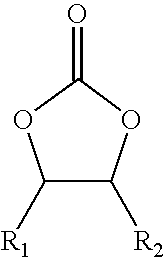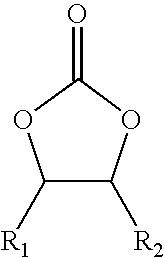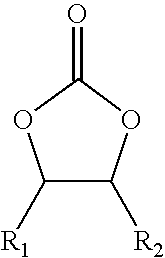Cyclic alkylene carbonate-derived isocyanate-terminated prepolymers, method for their preparation and their use
- Summary
- Abstract
- Description
- Claims
- Application Information
AI Technical Summary
Benefits of technology
Problems solved by technology
Method used
Image
Examples
examples
Preparation of the Isocyanate-Terminated Prepolymer
[0060]Normally, at low temperatures, the liquid stability of the isocyanate-terminated prepolymer can be characterized by its freezing point. In this invention, the freezing point was tested according to the following method:[0061]1) A glass tube with prepolymer sample sealed inside was put into an incubator at a predetermined temperature X° C. After the sample reached the predetermined temperature for a period of time (for example, 10 to 15 hours), the sample was checked as to whether any concretion or crystals appeared;[0062]2) If no concretion or crystals appeared, the predetermined temperature X° C. was decreased, the test process described in step 1) was repeated. If concretion or crystals appeared, the predetermined temperature X° C. was increased and the test process described in step 1) was repeated. X° C. was the freezing point of the isocyanate-terminated prepolymer if concretion or crystals appeared at a predetermined tem...
examples 1-10
[0069]4,4′-MDI (56 wt. %) and Bayflex 2003E (38 wt. %) were added into a reactor and reacted at 70° C. for 2 hours. The temperature of the reactor was reduced to 65° C. A carbodiimide-modified MDI (6 wt. %) was added into the reactor, stirred for 30 minutes, and then a mixture A was obtained. The temperature of the mixture A was reduced to room temperature. Propylene carbonate was added into the mixture A, wherein the amount of the propylene carbonate was listed in Table 1. The mixture A was stirred for 30 minutes and then a prepolymer was obtained. The test results of the prepolymer are listed in Table 1.
example 11
[0070]4,4′-MDI (43 wt. %) and Bayflex 2003E (51 wt. %) were added into a reactor and reacted at 70° C. for 2 hours. The temperature of the reactor was reduced to 65° C. A carbodiimide-modified MDI (6 wt. %) was added into the reactor, stirred for 30 minutes, and then a mixture B was obtained. The temperature of the mixture B was reduced to room temperature. Propylene carbonate (5 wt. %) was added into the mixture B. The mixture B was stirred for 30 minutes and then a prepolymer was obtained. The test results of the prepolymer were listed in Table 1.
TABLE 1Isocyanate-terminatedprepolymer(1)*(2)(3)(4)(5)(6)(7)(8)(9)(10)(11)Mixture (wt. %)100100100100100100100100100100100Propylene—1353.752.51.252.57155carbonate (wt. %)γ-butyrolactone————1.252.53.75————(wt. %)Diethyl oxalate———————2.5———(wt. %)NCO (wt. %)19.319.118.718.418.418.418.418.418.016.812.7Freezing point12119666554−3(±1° C.)*Comparative Examples
[0071]Table 1 demonstrates that the freezing point of isocyanate-terminated prepolyme...
PUM
| Property | Measurement | Unit |
|---|---|---|
| Percent by mass | aaaaa | aaaaa |
| Percent by mass | aaaaa | aaaaa |
| Percent by mass | aaaaa | aaaaa |
Abstract
Description
Claims
Application Information
 Login to View More
Login to View More - R&D
- Intellectual Property
- Life Sciences
- Materials
- Tech Scout
- Unparalleled Data Quality
- Higher Quality Content
- 60% Fewer Hallucinations
Browse by: Latest US Patents, China's latest patents, Technical Efficacy Thesaurus, Application Domain, Technology Topic, Popular Technical Reports.
© 2025 PatSnap. All rights reserved.Legal|Privacy policy|Modern Slavery Act Transparency Statement|Sitemap|About US| Contact US: help@patsnap.com



